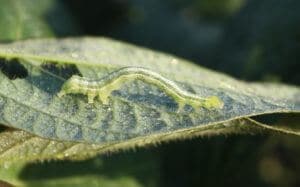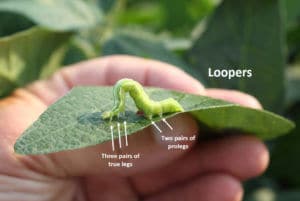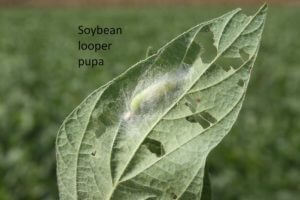Management options
| Insecticide (Trade Names) for LOOPERS | Lb Active Ingredient per Acre | Amount Formulation per Acre | Performance Rating Soybean / Cabbage |
|---|---|---|---|
| chlorantraniliprole (Vantacor 5 SC) | 0.067 - 0.097 | 1.71 - 2.5 oz | 8 / 9 |
| chlorantraniliprole, bifenthrin (Elevest) | See label | 5.6 - 9.6 oz | 8 / 9 |
| chlorantraniliprole, λ-cyhalothrin (Besiege) | See label | 10 - 12.5 oz | 8 / 9 |
| emamectin benzoate (Denim 0.16) | 0.01 - 0.015 | 8 - 12 oz | 9 / 9 |
| indoxacarb (Steward 1.25) | 0.09 - 0.11 | 9.2 - 11.3 oz | 9 / 9 |
| methoxyfenozide (Intrepid 2) | 0.06 - 0.16 | 4 - 10 oz | 9 / 9 |
| spinetoram (Radiant SC 1) | 0.033 - 0.0625 | 4.25 - 8 oz | 8? / 9? |
| spinetoram, methoxyfenozide (Intrepid Edge) | See label | 4 - 8 oz | 9 / 9 |
| spinosad (Blackhawk 36% WDG) | 0.056 - 0.072 | 2.4 - 3.2 oz | 9 / 9 |
- Plant early maturing varieties and avoid unnecessary insecticide applications that may disrupt populations of natural enemies.
- Bt cotton varieties typically provide good control, and supplemental insecticide applications are rarely needed.
- Insecticide applications can be terminated when cotton has accumulated 600-700 DD60s past NAWF5 (NAWF5 = average of 5 nodes above a first position white flower).


